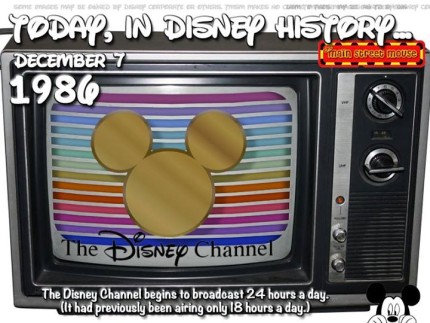Today In Disney History ~ December 7th
From Wiki:
The Disney Channel launched nationally as a premium channel on April 18, 1983 at 7:00 a.m. Eastern Time. The first program ever aired on the channel was also its first original series, Good Morning, Mickey!, which showcased classic Disney animated shorts. At the time of its launch, The Disney Channel’s programming aired for 16 hours each day,[7] from 7:00 a.m. to 11:00 p.m. Eastern and Pacific Time (comparatively, its competitors HBO, Cinemax, Showtime, The Movie Channel and Spotlight all had been operating on 24-hour programming schedules for a few years at the time). By the fall of 1983, the channel was available to more than 532,000 subscribers in the United States; this total would increase to 611,000 subscribers in December of that year.
Programming during the channel’s run as a premium service – carrying through to its transition to a basic cable channel – targeted children and teenagers during the morning and afternoon, families during prime time, and adults at night. The Disney Channel differed from other premium services in that it not only acquired broadcast rights to theatrical feature films, but, in addition to producing its own original programs, the channel aired several television series that were acquired through corporate sister Buena Vista Television and other program distributors. In its first years, The Disney Channel’s programming included original series such as Welcome to Pooh Corner and You and Me Kid, along with several foreign-imported animated series and movies including Asterix, The Raccoons, Paddington Bear and the Australian western Five Mile Creek; in addition to movies, the original late night schedule also featured reruns of The Adventures of Ozzie and Harriet.
The channel’s daytime schedule during its existence as a pay service was populated primarily by series aimed at children (as opposed to the movie-driven daytime lineups of other premium services), interspersed with a limited number of movies – usually a single daytime feature on weekdays, and two or three films on weekends, along with occasional live-action and animated specials for children. The nighttime schedule featured a mix of theatrical, made-for-cable and straight-to-video films (recent and older family-oriented movies were shown in the early evenings, while classic films – mainly releases from the 1930s to the 1960s – usually ran during the late evening and overnight hours) and original specials (primarily in the form of concerts, variety specials and documentaries). D-TV, a short segment featuring popular music interwoven with scenes from Disney’s animated shorts and feature films, also periodically aired as filler between shows. Unlike other premium services, The Disney Channel opted not to disclose a film’s Motion Picture Association of America-assigned rating prior to the start of the feature (the only bumpers appearing at the start of programs indicated closed captioned programs, as well as on rare occasions, parental advisories for feature films).
The channel’s primary logo (which was used until 1997, although it began to be used on-air less frequently beginning in September 1995) featured multiple lines resembling a television screen that featured a negative space silhouette of Mickey Mouse’s head; IDs shown before programs between 1986 and 1997 generally involved Mickey – whose arms are only shown – being involved in various situations (such as him having a nightmare in which the “Mickey Mouse TV” logo chases and then engulfs one of his gloves, Mickey wiping a foggy window or Mickey making shadow figures on a flashlight-lit wall) that featured the logo being formed or displayed in various ways.
For its subscribers, the channel provided a monthly (and later bi-monthly) program guide/magazine called The Disney Channel Magazine, which in addition to carrying listings for the channel’s programming, had also carried feature stories on upcoming programs (the magazine also lent its name to a series of interstitials seen during promotional breaks on the channel that provided behind-the-scenes looks at The Disney Channel’s programming). The Disney Channel Magazine ceased publication in early 1997 and was replaced by Behind the Ears (a print magazine which also shared its name with another series of behind-the-scenes interstitial that aired on the channel from 1997 to 2000) as the channel began primarily operating as a commercial-free basic channel.
Besides The Disney Channel Magazine and DTV, interstitial segments that padded out extended promotional breaks between programs (usually those seen within its nighttime schedule) during this period included A Disney Moment (featuring clips from Disney feature films and animated shorts); Backstage Pass (behind-the-scenes segments profiling upcoming Disney film and television projects); Dateline Disney (a generalized segment focusing on Disney’s various filmed and themed entertainment projects; Dateline Walt Disney World and Dateline Disneyland were offshoots that aired from the late 1980s to mid-1990s which focused on attractions at the Disney theme parks); Walt Disney Imagineering (focusing on Disney projects from animation to attractions at the Disney theme parks); and Discover Magazine (an informative science and technology segment that was produced in conjunction with the magazine of the same name).
As a premium channel, The Disney Channel often ran free previews of five days to one week in length four times annually, as well as two periodic weekend-only previews (with ads targeted to cable and satellite customers who were not subscribers to the channel); this resulted in The Disney Channel offering more preview events each calendar year during its tenure as a pay service than HBO, Cinemax and Showtime had run during that time frame. In April 1984, the channel extended its daily programming to 18 hours (from 7:00 a.m. to 1:00 a.m. Eastern and Pacific Time), with the addition of two hours onto its late night schedule.
TMSM Today in Graphic by Sherry Rinaldi DeHart
- Disney Adventure World: Disneyland Paris Reimagines 2nd Park - April 12, 2024
- Honest Review – 1900 Park Fare Reopens at the Grand Floridian - April 11, 2024
- Hungry? Give City Works at Disney Springs a try! - April 9, 2024





